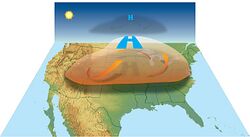Earth:Heat dome
A heat dome is caused when atmosphere traps hot ocean air, as if bounded by a lid or cap. Heat domes happen when strong high pressure atmospheric conditions remain stationary for an unusual amount of time, preventing convection and precipitation and keeping hot air "trapped" within a region. This can be caused by multiple factors, including sea surface temperature anomalies and the influence of a La Niña.[1][2] The upper air weather patterns are slow to move, referred to by meteorologists as an Omega block.[3]
Creation of heat domes
In still, dry summer conditions, a mass of warm air builds up. The high pressure from the Earth's atmosphere pushes the warm air down. The air is compressed, and as its net heat is now in a smaller volume, so it must get hotter. As the warm air attempts to rise, the high pressure above it forces it down, to get hotter, and its pressure grows higher.[4]
The high pressure acts as a dome, causing everything below it to get hotter and hotter.[5] The term is often extrapolated in the media terminology for any heat wave situation. The term heat dome is also used in the context of urban heat islands.[6]
Examples

In chronological order,
- 1936 North American heat wave
- 2012 North American heat wave
- 2018 North American heat wave
- 2021 Russia heatwave
- 2021 British Columbia wildfires
- 2021 Western North America heat wave
- 2023 Western North America heat wave
- 2023 South America heat wave
See also
References
- ↑ "What is a heat dome?". June 30, 2021. https://oceanservice.noaa.gov/facts/heat-dome.html.
- ↑ Burga, Sulcyre (27 July 2023). "What to Know About Heat Domes—And How Long They Last" (in en). Time. https://time.com/6299072/what-to-know-about-heat-domes-and-how-long-they-last/.
- ↑ Freedman, Andrew (July 25, 2019). "A Giant 'Heat Dome' Over Europe Is Smashing Temperature Records, And It's on The Move". https://www.sciencealert.com/in-europe-a-historic-heat-wave-is-shattering-records-with-ease.
- ↑ Rosenthal, Zachary (July 1, 2021). "Extreme heat". https://www.accuweather.com/en/weather-news/what-is-a-heat-dome/971124.
- ↑ Fleming, Sean (June 29, 2021). "What is the North American heat dome and how dangerous is it?". https://www.weforum.org/agenda/2021/06/north-american-heat-dome-dangerous/.
- ↑ Lacroux, Margaux. "Qu'est-ce que le «dôme de chaleur» qui fait suffoquer le Canada ?" (in fr). https://www.liberation.fr/environnement/climat/quest-ce-que-le-dome-de-chaleur-qui-fait-suffoquer-le-canada-20210628_JFZKWPBTUFHODB4Y77IFF53AMU/.
External links
- What is a Heat Dome?—Scientific American
- BBC reference
- sky.com reference
- telegraph.co.uk reference
- severe-weather.eu/ on heat domes
- YouTube reference
 |


